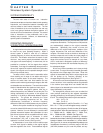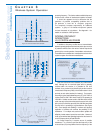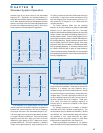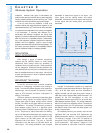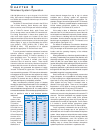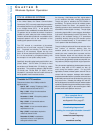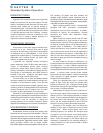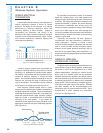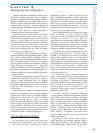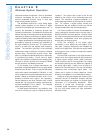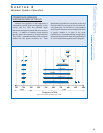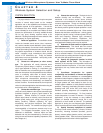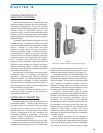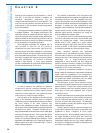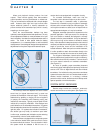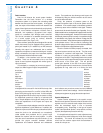
Important transmitter characteristics are power output
and antenna efficiency. Maximum power is limited by
government regulations and battery capability. Antenna
efficiency is limited by size and design. Recall that the
efficiency of typical wireless transmitter antennas is fairly
low, about 10% or less for VHF. This means that for a 50
mW VHF transmitter the effective radiated power (ERP) is
less than 5 mW. This may be further attenuated by
proximity to the body or other lossy objects.
Important receiver characteristics are antenna
efficiency, receiver sensitivity and the ability of the
receiver to reject unwanted signals and noise. Antenna
efficiency is again limited by size and design but
receiver antennas tend to be much more efficient than
transmitter antennas since they can be made large
enough to be better tuned to the proper frequency.
Other receiver characteristics are limited by design.
Both elements are limited by cost.
The transmission path is characterized by distance,
intervening obstructions and propagation effects. Losses
due to these characteristics are generally frequency
dependent: the higher the frequency the greater the loss.
Once the operating frequency is chosen, only the path
length and antenna locations are controllable. These are
usually limited by the application itself. Under good
conditions (line-of-sight) at a distance of about 100 ft. the
field strength of the signal from a 50 mW transmitter is on
the order of 1000 uV/m, well within the range of sensitivity
of a typical receiver.
Finally, RFI is characterized by its spectrum, that is,
its distribution of amplitude and frequency. It typically
consists of both broadband noise and discrete
frequencies. However, its strength can be comparable
to or greater than the desired signal in poor conditions.
Except for a few predictable sources it is largely
uncontrollable.
Rather than quote a specific maximum operating
distance most manufacturers of wireless microphone
systems give a "typical" range. For systems of the type
discussed here (10-50 mW, VHF or UHF) the typical
range may vary from 100 ft. to 1000 ft. The lower
number represents a moderately severe environment
while the upper figure might be achieved in absolute
ideal conditions. Extremely poor conditions could
result in a range of only 50 feet or less. It is impossible
to accurately predict the range of an arbitrary wireless
microphone system in an arbitrary application.
DIGIT
AL WIRELESS SYSTEMS
As other links in the audio chain have been
converted to the digital domain it is of interest to look
at the impact of digital technology on wireless
transmission systems. Digital techniques can be
applied to professional wireless in several ways, each
offering potential benefits. The first level of application
has been the use of digital control circuits for various
tasks such as frequency selection, diversity antenna
switching and most display functions. Nearly all
frequency-agile wireless systems benefit from the use
of digital controls and digital displays.
The next digital application level employs DSP (Digital
Signal Processing) to replace traditional analog
companding circuits. An audio DSP circuit is used in the
transmitter to optimize the input signal for
transmission and a complementary audio DSP is used in
the receiver to optimize the output signal. The radio
transmission path is still in the analog domain. Benefits
may include increased audio dynamic range, decreased
companding artifacts, and wider frequency response.
The highest level of digital implementation uses a
fully digital transmission path. The input signal is
digitized in the transmitter and remains in the digital
domain until the receiver output. It is even possible to
output a digital signal from the receiver to subsequent
digital equipment. Potential benefits of an all-digital
wireless approach include both improved audio quality
and improved radio transmission. However, the
technical requirements are not trivial and the inevitable
compromise between performance and cost requires
some difficult decisions.
In concept, fully digital wireless transmission is
simple. Add an analog-to-digital (A/D) converter at the
input of the transmitter. Transmit the resulting digital
information to the receiver. Demodulate the digital
information and add a complementary digital-to-analog
(D/A) converter at the output of the receiver. The
ultimate limitation lies in the amount of digital
information that must be reliably transmitted for
acceptable audio quality.
In general, information transmission techniques
(wired or wireless) must balance bandwidth limitations
with hardware (and software) complexity. Bandwidth
refers to the range of frequencies and/or amplitudes
used to convey the information. In audio, a frequency
range of 20-20,000Hz and an amplitude range
(dynamic range) of 120dB is perhaps the ultimate goal.
However, a frequency range of 300-3000Hz and a
dynamic range of 30dB are sufficient for telephone-
quality speech. As expected, high fidelity audio
equipment tends to be more complex and costly than
telephone equipment.
In analog FM radio systems, audio fidelity is
greatly dependent on allowable deviation, which is
related to RF bandwidth: wider deviation increases
occupied bandwidth. Walkie-talkies use less band-
33
Selection
and Operation
of Wireless Microphone Systems
C HAPTER 3
Wireless System Operation



